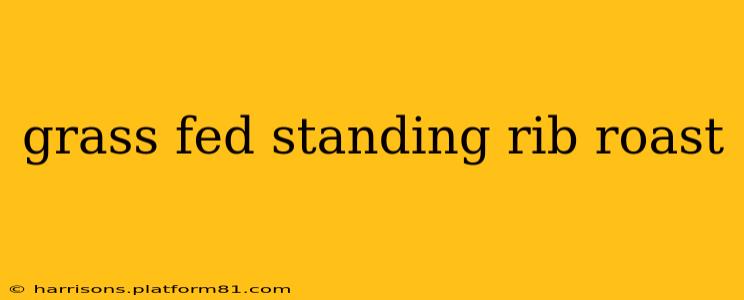The standing rib roast, a majestic centerpiece for any celebratory meal, takes on a whole new level of flavor and quality when sourced from grass-fed cattle. This guide delves into everything you need to know about this exceptional cut, from selecting the perfect roast to achieving the ideal cooking result. Prepare to elevate your culinary game with this rich, flavorful, and incredibly tender experience.
What is a Grass-Fed Standing Rib Roast?
A standing rib roast is a primal cut of beef taken from the rib section of the cow. It's known for its marbling (intra-muscular fat) that contributes to tenderness and flavor. A grass-fed standing rib roast comes from cattle raised exclusively or predominantly on pasture, without the addition of grain in their diet. This results in a leaner cut of meat with a distinct, slightly gamier flavor profile compared to grain-fed counterparts. The meat is often described as having a richer, more complex taste with a deeper red hue.
How Does Grass-Fed Differ from Grain-Fed?
The primary difference lies in the cattle's diet. Grain-fed cattle are typically finished on a diet of corn or other grains for several months before slaughter, resulting in a higher level of marbling and a more tender, buttery texture. Grass-fed beef, however, maintains a leaner profile with less marbling, leading to a more intense flavor and potentially a slightly tougher texture if not cooked properly. However, many find the robust taste of grass-fed beef far superior.
How to Choose the Perfect Grass-Fed Standing Rib Roast?
Selecting the right roast is crucial for a successful outcome. Look for a roast with good marbling throughout, even if it's less than you'd see in a grain-fed roast. The color should be a deep red, and it should feel firm to the touch. Ask your butcher for advice; they can help you choose a roast based on your desired level of doneness and the number of guests you're serving. Consider the weight – a larger roast will require longer cooking time.
What is the Best Cooking Method for a Grass-Fed Standing Rib Roast?
Roasting is the quintessential cooking method for a standing rib roast. Slow roasting in the oven at a lower temperature ensures even cooking and maximum tenderness. The lower temperature allows the connective tissues to break down, resulting in a succulent and flavorful roast. You can also use a meat thermometer to ensure the roast reaches your desired internal temperature.
How Long Does it Take to Cook a Grass-Fed Standing Rib Roast?
Cooking time depends heavily on the weight and desired level of doneness. As a general rule, plan for approximately 20-25 minutes per pound at 325°F (163°C) for medium-rare. Always use a meat thermometer to check the internal temperature, as this is the most accurate way to determine doneness.
What is the Best Internal Temperature for a Grass-Fed Standing Rib Roast?
The ideal internal temperature depends on personal preference:
- Rare: 125-130°F (52-54°C)
- Medium-Rare: 130-135°F (54-57°C)
- Medium: 135-140°F (57-60°C)
- Medium-Well: 140-145°F (60-63°C)
- Well-Done: 145°F+ (63°C+)
Remember that the roast will continue to cook slightly after being removed from the oven (carry-over cooking).
Can You Sear a Grass-Fed Standing Rib Roast?
Searing the roast before roasting adds a beautiful crust and enhances the flavor. Use high heat and a little oil to sear all sides before transferring it to the oven.
How Do I Rest a Grass-Fed Standing Rib Roast?
Allowing the roast to rest for at least 20-30 minutes after cooking is crucial. This allows the juices to redistribute throughout the meat, resulting in a more tender and flavorful roast.
What are Some Serving Suggestions for Grass-Fed Standing Rib Roast?
The possibilities are endless! Consider serving your grass-fed standing rib roast with classic sides like roasted potatoes, asparagus, Yorkshire pudding, or a rich gravy made from the pan drippings.
This comprehensive guide provides a solid foundation for preparing a truly exceptional grass-fed standing rib roast. Remember, patience and attention to detail are key to unlocking the full potential of this remarkable cut of beef. Enjoy!
